13 February 2024: Database Analysis
Exercise Therapy Research in Ankylosing Spondylitis-Induced Back Pain: A Bibliometric Study (2004–2023)
Jiang-xia Zheng1ABCDEFG, Xi-feng Zhang1ABCD, Sheng-hui Liu1BCDF, Feng Ye1BDEF, Sen-guo Ji1BCDE, Xiu-zhen Wen1ABCDEFG*DOI: 10.12659/MSM.943196
Med Sci Monit 2024; 30:e943196
Abstract
BACKGROUND: Ankylosing spondylitis (AS), a chronic inflammatory disease predominantly causing back pain, affects up to 0.5% of the global population, more commonly in males. Frequently undiagnosed in early stages, AS is often associated with comorbid depression and anxiety, imposing significant healthcare burdens. Despite available pharmaceutical treatments, exercise therapy (ET) has emerged as an effective, side-effect-free alternative, particularly for managing AS-induced back pain. This study aims to explore the research trends in ET for treating AS back pain from 2004-2023.
MATERIAL AND METHODS: A comprehensive analysis of 437 articles, sourced from the Science Citation Index-Expanded within the Web of Science Core Collection, was conducted using CiteSpace 6.2.R5. This study spanned from 2004 to October 15, 2023, examining publications, authors, institutions, and keywords to assess keyword co-occurrences, temporal progressions, and citation bursts.
RESULTS: Research interest in ET for AS began escalating around 2008 and has since shown steady growth. The USA emerged as a significant contributor, with Van der Heijde, Désirée, and RUDWALEIT M being notable authors. Key institutions include Assistance Publique Hopitaux Paris and UDICE-French Research Universities, with ANN RHEUM DIS being the most influential journal. The field's evolution is marked by interdisciplinary integration and branching into various sub-disciplines.
CONCLUSIONS: Exercise therapy for AS-induced back pain is a growing research area, necessitating further exploration in clinical management and rehabilitation strategies. The relationship between ET and osteoimmunological mechanisms remains a focal point for future research, with a trend towards personalized and interdisciplinary treatment approaches.
Keywords: Back Pain, Bibliometrics, Exercise Therapy, Spondylitis, Ankylosing
Background
Ankylosing spondylitis (AS) is an idiopathic chronic inflammatory disease primarily affecting the axial joints [1,2], characterized by the typical clinical manifestation of back pain [3,4]. The global prevalence of AS ranges from 0.2% to 0.5% [5], with a male-to-female AS prevalence ratio of 1.70 to 1.21[6], and the disease is often overlooked in its early stages [7]. Several studies have shown that AS patients often experience comorbid depression and anxiety [8–10]. Therefore, besides the physical and physiological consequences, it is essential to acknowledge that AS has imposed a substantial financial burden on healthcare systems in various countries. Consequently, the development of effective clinical diagnostic and treatment strategies for AS is a shared goal for both healthcare professionals and patients.
Indeed, while there are various pharmaceutical therapies for AS in clinical practice, such as nonsteroidal anti-inflammatory drugs (NSAIDs) in combination with opioids [11], and tumor necrosis factor-alpha (TNF-α) antagonists [12], concerns persist regarding their effectiveness and potential adverse effects, such as nausea, peptic ulcers, gastrointestinal hemorrhage, and elevated blood pressure [13]. Moreover, it is imperative to acknowledge that opioid medications yield a significant potential for heightened rewards, yet protracted utilization can engender opioid misuse and dependency [14]. Consequently, this compels both healthcare practitioners and patients to ardently explore substitute or complementary therapeutic interventions.
Exercise therapy (ET) has emerged as a fundamental rehabilitative strategy, distinguished by its merits of being devoid of adverse effects, efficaciousness, and cost-effectiveness [15]. It has garnered significant attention in both clinical application and scholarly inquiry in recent years. A multitude of studies have underscored the unique clinical benefits of ET for back pain in AS, and high-quality randomized controlled trials (RCTs) [16–19] and comprehensive reviews [20–22] have shed light on the safety and efficacy of ET. This shows that ET is progressively evolving into a standardized and universally embraced therapeutic modality. However, there is still a lack of bibliometric studies on the cooperation, development trends, and research fronts in the field of ET for back pain in AS. This shortfall encompasses the taxonomy of research orientations, auspicious and prevalent research domains, and the trajectory of developmental trends within this discipline.
CiteSpace software is a visual tool with the capacity to both qualitatively and quantitatively illuminate the interconnected contributions of authors, regions, institutions, and their collaborative networks [23,24]. Its most salient feature is the discernment of research focal points and cutting-edge areas, as well as the prediction of future developmental trajectories within specific fields. In contrast to traditional literature reviews and meta-analyses, the bibliometric analysis facilitated by CiteSpace software offers a more profound and insightful perspective [25–27]. The objective of this study was to determine the forefront and evolving trends of ET for the management of back pain in AS. This exploration was conducted by scrutinizing core authors, their collaborative networks, affiliated institutions, countries and regions, and a network analysis of keywords spanning the past decade using CiteSpace.
Material and Methods
DATA SOURCES AND SEARCH STRATEGY:
The entirety of data employed in this study was sourced from the Science Citation Index-Expanded (SCI-E) within Thomson Reuters’ Web of Science Core Collection (WoSCC), widely acknowledged as the preeminent online database in this domain. The data search strategy encompassed the key topics of “ankylosing spondylitis,” “back pain,” and “exercise therapy” (Figure 1). The search covered publications from the last 20 years (October 16, 2004, to October 15, 2023) and was completed within a single day on October 15, 2023. Only papers published in English and categorized as articles were included, with no restrictions on the country of publication or study type [28–30]. The search strategies and results are meticulously detailed in Table 1. In total, 437 articles were retrieved, and after importing them into CiteSpace for deduplication, it was ascertained that there were no duplicate entries.
ANALYSIS TOOL:
The cartographic representation produced by CiteSpace 6.2.R5 encompasses citation tree rings and interconnecting lines. Citation tree rings serve to elucidate the incidence and citation frequencies of the scrutinized documents. The hues of these rings align with the temporal dimension of citation, with thickness denoting the magnitude of citations within the respective period. Regarding the lines linking diverse nodes, their color is contingent upon the inaugural co-occurrence time of a specific node, while thickness signifies the robustness of the co-occurrence relationship. The hierarchical arrangement of network nodes is determined by their significance, gauged through the utilization of the betweenness centrality index. CiteSpace utilizes this metric to ascertain and appraise the significance of literature, symbolized by purple circles encapsulating pivotal publications, authors, journals, and institutions. Nodes with pronounced centrality and recurrent presence serve as conduits for delving into pivotal inquiries and delineating research domains of particular interest within the ambit of ET for back pain in AS.
The parameters used in CiteSpace were as follows: the time slice covered the years from 2004 to 2023, with one year per slice. All terms were included, such as “Title,” “Abstract,” “Author Keywords,” and “Keywords Plus.” To enhance the clarity of the final generated graph and facilitate the observation of relationships between publications, we have set the g-index’s k-value to 50 and employed the Pathfinder algorithm [23,31,32].
Results
ANNUAL PUBLICATIONS AND TRENDS:
Subsequent to a thorough database search, a total of 437 articles, aligning with the focus of this study, were encompassed in our analysis. Figure 2 provides a visual representation of the annual distribution of published articles. From 2004 to 2007, there were no relevant publications on ET for back pain in AS. It was not until 2008 that this field began to attract academic attention. Throughout the 10-year period from 2009 to 2018, the annual publication output exhibited a relatively stable trend, hovering around 27 papers, with fluctuations not exceeding 12 papers. This stability can be attributed to the fact that ET had not yet gained widespread popularity in the treatment of AS during this timeframe. Starting in 2018, there was a steady growth in annual publications, with an increase of approximately 10%. We observed that 2018 marked a year of global awareness for AS, accompanied by the release of an international consensus on the treatment of AS with ET. These factors collectively propelled the adoption and attention toward ET as a therapeutic approach for AS [33]. As of October 2023, there have already been 24 articles published this year. Given the current trend, it is anticipated that the annual publication output for this year will remain around 40 papers. In summary, in the field of ET for back pain in AS, it only began to receive academic attention in 2008 and has since exhibited a stable and modest growth pattern.
ANALYSIS OF AUTHORS AND CITED AUTHORS:
The analysis of the authors behind the 437 publications revealed an intricate network comprising 386 nodes, each representing an individual author, interconnected by a total of 624 links, as elegantly depicted in Figure 3. A comprehensive evaluation of these erudite contributors has illuminated the top 10 authors in this scholarly domain, with Désirée van der Heijde assuming a preeminent position by virtue of an impressive portfolio of 12 articles. Close behind, we find luminaries such as Xenofon Baraliakos (10), Maxime Dougados (9), Laure Gossec (8), Hatice Bodur (8), Juergen Braun (7), Ann Bremander (5), Vibeke Strand (4), John C Davis (4), and Uwe Lange (4), meticulously documented in Table 2. Compared to all the authors, Désirée van der Heijde entered the field of ET for back pain in AS relatively late. However, her total publication output ranks first, making her the most prominent expert in this field. Additionally, among the top 10 authors, 70% are from Europe.
The map of the cited authors comprises 535 nodes and 3439 links (Figure 4). M Rudwaleit had the highest citation count (155 citations), followed by A Calin (152), J Braun (146), S Vanderlinden (145), and S Garrett (133) (Table 3). The top 10 centralities of the cited authors included H Dagfinrud (0.1), J Braun (0.09), M Rudwaleit (0.08), LC Doward (0.08), JF Fries (0.08), M Dougados (0.07), MM Ward (0.07), A Boonen (0.07), P Machado (0.07), and Y Akkoc (0.07) (Table 3). The above data highlight the level of attention received by the cited authors in this field.
ANALYSIS OF COUNTRIES AND INSTITUTIONS:
The analysis of country distribution reveals a network composed of 65 nodes interconnected by 382 links, as depicted in Figure 5. The 437 references have been contributed by researchers representing 65 countries, with the top 10 countries in terms of centrality (highlighted by the purple ring) including the England (0.22), Mexico (0.22), Canada (0.2), the USA (0.14), Colombia (0.14), Denmark (0.11), Sweden (0.11), and The Netherlands (0.1). From the ranking of national centrality, it is evident that among the top 10 countries, 8 countries have exhibited strong centrality. Moreover, through the connections, it can be observed that there is a substantial network of collaboration among these countries with higher publication outputs. This indicates that the field of ET for back pain in AS has gradually begun to receive attention from various countries worldwide (Table 4).
The institutional network, as illustrated in Figure 6, comprises 293 nodes interconnected by 1174 links. A total of 293 institutions have been actively engaged in research ET for back pain in AS. The top 10 institutions, based on the number of publications, are the Assistance Publique Hopitaux Paris (APHP) (33 articles), UDICE-French Research Universities (33), Hopital Universitaire Cochin-APHP (30), Universite Paris Cite (28), Leiden University (25), Leiden University Medical Center (LUMC) (25), Hopital Universitaire Hotel-Dieu (APHP) (24), Hopital Universitaire Paul-Brousse (APHP) (23), Leiden University-Excl (LUMC) (24), and Hopital Universitaire Necker-Enfants Malades (APHP) (19), as detailed in Table 5. From the institutional ranking, it is notable that the top-ranking institution, Assistance Publique Hopitaux Paris, is part of the APHP group. In the top 10 academic institutions, half of them belong to the APHP group, underscoring the authority of this group in the field of ET for back pain in AS. Additionally, Leiden University holds a significant academic position, with 2 affiliated institutions ranking in the top 10 (Leiden University Medical Center and Leiden University – Excl).
Currently, the USA leads globally in terms of author quantity, publication output, academic institutions, and other relevant aspects. On the contrary, countries in Africa and elsewhere are not prominently featured at the forefront. This observation suggests a positive correlation between the adoption of ET and the developmental level of countries.
ANALYSIS OF CITED JOURNALS:
Figure 7 and Table 6 provide a comprehensive view of the cited journals in the domain of ET for back pain in AS from 2004 to 2023. It is worth noting that the latest impact factor for the ANN RHEUM DIS journal is 27.4. This journal is not only a top-tier publication in the field of rheumatology but also holds the leading position in the ranking of ET for back pain in AS. Additionally, both ACTA REUMATOL PORT and ANN INTERN MED have also demonstrated strong centrality in this field (purple circles). The top 10 cited journals, as ranked, all exhibit outstanding contributions within the field, reflecting the high level of recognition of these journals by researchers.
KEYWORDS CO-OCCURRENCE AND CITATION BURST ANALYSIS:
Examination of the keywords exhibiting elevated centrality and frequency disclosed a network comprising 394 nodes interconnected by 2568 lines (Figure 8). Based on their combined frequency and centrality, discernible keywords emerged, with “ankylosing spondylitis,” “quality of life,” “pain,” “disease activity,” and “exercise” standing out as prominent entries in Table 7.
Figure 9 illustrates the top 20 keywords exhibiting the most robust citation bursts from 2004 to 2023. Beyond delineating developmental trajectories and research frontiers, this depiction serves to pinpoint current research hotspots and priorities. The initiation and conclusion of each burst are delineated as “begin” and “end,” respectively. The augmentation in impact correlates with an escalation in the “intensity” value. The light blue region demarcates the study period, while the red segments signify the onset and culmination of a burst. The keywords with the strongest citation bursts over the past 20 years reveal an interesting evolution. In the early years, terms such as “infliximab” and “physiotherapy” received significant scholarly attention. However, in recent years, keywords like “inflammation” and “back pain” have become focal points of research. This suggests a shift among researchers from initial characteristic studies toward investigations into the underlying mechanisms. Notably, “population” and “physical function” are the keywords with the longest burst duration, emphasizing that, within the field of ET for back pain in AS, the health management and quality of life of patients have consistently remained central to academic investigation.
KEYWORDS TIMELINE:
Figure 10 provides a chronological overview map delineating the 8 discrete co-citation clusters (identified by numbers 0 to 7) and their interconnections. The temporal axis, progressing from left to right, elucidates the emergence and disappearance of research keywords spanning the period from 2004 to 2023. Simultaneously, the graphic encapsulates the structural details inherent to each cluster.
Timeline view shows that the first cluster (#0), labeled as “exercise,” focused on pain, quality of life, bath, management, and exercise. Cluster (#1), labeled as “magnetic resonance imaging,” focused on criteria, arthritis, ankylosing spondylitis, prevalence, classification, back pain, spondyloarthritis, and recommendations. Cluster (#2), labeled as “rheumatoid arthritis” focused on rheumatoid arthritis, index, disability, and health assessment questionnaire. Cluster (#3), labeled as “society classification criteria,” focused on psoriatic arthritis, double-blind, Ankylosing Spondylitis Disease Activity Score (ASDAS), and society classification criteria. Cluster (#4), labeled as “ankylosing spondylitis,” focused on reliability, axial spondyloarthritis, and clinical history. Cluster (#5), labeled as “posterior approach,” focused on low back pain, association, and outcm. Cluster (#6), labeled as “disease activity,” focused on validity, disease activity, population, and functional disability. Cluster (#7), labeled as “running,” focused on exercise, pain, shoulder, risk-factors, and foot. Cluster (#8), labeled as “spinal mobility,” focused on placebo-controlled trial, spinal mobility, safety, and inflammation.
CLUSTER DEPENDENCIES OF REFERENCE:
Figure 11 illustrates the cluster dependencies based on reference literature. Different color-coded regions represent distinct clusters of reference literature, while the arrows denote the developmental relationships between these clusters. Convergence of arrows indicates the emergence of disciplinary branches, while convergence of nocks suggests interdisciplinary fusion. This is because arrow tails signify the most recent knowledge frontiers, whereas nocks represent sources of foundational literature. By examining the cluster dependencies of reference, it is apparent that the development pattern in the field of ET for back pain in AS primarily demonstrates a combination of interdisciplinary fusion and disciplinary branching, indicating the coexistence of these 2 patterns. For instance, #0 “exercise” serves as a central node in the clustering. It not only shows 3 instances of interdisciplinary fusion (#3 “sacroiliac,” #4 “treatment,” and #6 “adalimumab”) but also exhibits 3 instances of disciplinary branching (#1 “anti-tnf treatment,” #2 “magnetic resonance imaging,” and #7 “cognitive”). This represents a typical pattern of interdisciplinary fusion. On the other hand, #4 “treatment” and #6 “adalimumab” each branch into #3 “sacroiliac joint” and #0 “exercise,” which represents a typical pattern of disciplinary specialization.
Discussion
GENERAL INFORMATION:
This study shows that, within the realm of ET for back pain in AS, a total of 437 articles have been published over the past 2 decades. Commencing from the year 2008, this domain began to pique the scholarly community’s interest, subsequently manifesting a steady and gradual ascent. To date, the annual publication output within this field remains relatively modest. However, considering the juxtaposition of the limited curative efficacy of pharmaceutical interventions for AS with the safety and effectiveness of exercise therapy [34], it is conceivable that this domain will likely garner heightened academic scrutiny in the forthcoming years.
Through the amalgamation of author collaboration networks, and the contemplation of their affiliations within the context of national and institutional cooperative alliances, it becomes evident that numerous nations and academic institutions worldwide have nurtured adept research collectives. A number of these collectives have already made significant contributions of high-impact to top-tier international journals [35–38]. Moreover, the presence of relatively intimate collaborative ententes between these countries and institutions portends a propitious course for this field in the upcoming 5–10 years, potentially engendering a proliferation of research outcomes possessing considerable impact.
By discerning the clustering interdependencies within the references, it is plausible to infer that the developmental pattern within the realm of ET for Back Pain in AS encompasses a dual modality, wherein interdisciplinary amalgamation coexists with the proliferation of disciplinary sub-branches. This distinctive characteristic is highly likely to catalyze resource consolidation, interdisciplinary ideational exchange, and scholarly innovation within this domain.
Nonetheless, these academic collectives continue to exhibit conspicuous disparities in their research capabilities. For instance, certain academic institutions within the United States have attained preeminent standing in this field, courtesy of their advanced technology and seasoned talent pool. In the European region, academic institutions surpass their Asian counterparts in both publication volume and scholarly impact. It is imperative to note that, even though regions such as Africa have few academic institutions, this should not be misconstrued as a corollary of lower disease incidence within these areas.
In summary, research in the field of ET for back pain in AS has established a relatively mature development framework. In the future, it is essential to strengthen collaboration among academic institutions, enhance data sharing, and foster interdisciplinary innovation. It is believed that in the not-too-distant future, significant progress can be achieved, ultimately providing effective, high-quality solutions for AS patients.
RESEARCH HOTSPOTS:
Keywords contained the core content and central topics of research within a given field. Through keyword co-occurrence analysis, keyword clustering, and keyword citation bursts, one can monitor the development of various hotspots in a specific domain. In summary, within the field of ET for the treatment of bank pain in AS, 2 primary research focuses have emerged: the clinical management and rehabilitative strategies, and the mechanisms between ET and osteoimmunology.
CLINICAL MANAGEMENT AND REHABILITATIVE STRATEGIES:
It is widely recognized that ET is a fundamentally distinct rehabilitation modality from pharmacological treatments [39], offering a safe and effective approach [15–22,40,41]. In the context of treating bank pain with AS, 2 pivotal scientific inquiries arise. Firstly, what ET regimen is optimal? Presently, a myriad of ETs have demonstrated favorable clinical efficacy in the treatment of back pain in AS. These include, but are not limited to, the traditional Chinese Baduanjin qigong exercise prescription [42–44], aquatic exercise [45–47], Swiss ball exercises [48], and Pilates [49]. Furthermore, dedicated research [50] has undertaken comparative analyses of the clinical effectiveness of diverse exercise modalities, revealing that various specific types of exercise manifest substantial therapeutic benefits for AS. Among these, a combination of flexibility training, muscle strength conditioning, and aerobic exercises appears to yield optimal results. Secondly, how can patient adherence to ET be enhanced? Multiple studies have indicated that, due to the inherent inertia of AS patients, education and vigilant supervision serve as efficacious measures to ensure their adherence to exercise routines [18,51,52].
MECHANISMS BETWEEN ET AND OSTEOIMMUNOLOGY:
As ET for the management of back pain in AS progressively garners attention from both healthcare professionals and patients, the underlying mechanisms have become a central topic of interest for researchers. Specifically, they are focusing on how ET modulates a spectrum of cytokines and molecular factors expressed within the skeletal and immune systems. Research indicates that aerobic exercise can reduce the levels of C-reactive protein within AS patients [53], and another study demonstrates that ET can stimulate the expression of interleukin-6 (IL-6) and TNF-α through muscle contractions [54]. Additionally, several studies suggest that the central role of ET is to ameliorate the skeletal balance of AS patients [17,43,55–57]. Current mechanistic studies tend to focus on local tissues. Future research should complement these by investigating the neural regulatory mechanisms of AS at higher centers such as the spinal cord and brain.
LIMITATIONS:
This study has several limitations. First, it focused on the data available in the WoSCC database. CiteSpace is unable to integrate data from different databases or conduct citation analysis on sources outside the WoSCC. Second, while CiteSpace is valuable for detecting and visualizing emerging trends, it does not provide an in-depth discussion of the fundamental mechanisms behind ET for back pain in AS. Therefore, this study may not offer a comprehensive understanding of the underlying processes. Despite these limitations, we utilized CiteSpace to present the latest research trends in the field of ET for back pain in AS.
Conclusions
The domain of ET for back pain in AS warrants further exploration. The most notable research hotspots include clinical management and rehabilitation strategies, as well as the mechanisms between ET and osteoimmunology. In the future, researchers can make full use of existing national and academic collaborative networks, exploring more influential and clinically valuable research outcomes from an interdisciplinary perspective.
Data Availability
The raw data can be directly obtained from the Web of Science Core Collection (WoSCC), and further inquiries can be directed to the corresponding author.
Figures
 Figure 1. Map of literature screening process related to exercise therapy for back pain in ankylosing spondylitis. CiteSpace 6.2.R5 was created by Dr. Chaomei Chen, Professor of Computer and Information Science at Drexel University in the United States.
Figure 1. Map of literature screening process related to exercise therapy for back pain in ankylosing spondylitis. CiteSpace 6.2.R5 was created by Dr. Chaomei Chen, Professor of Computer and Information Science at Drexel University in the United States. 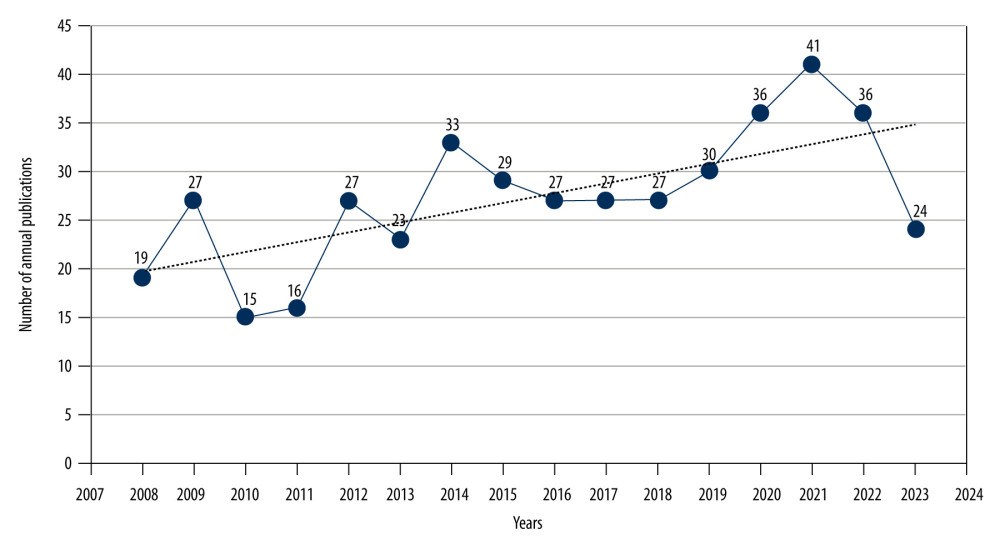 Figure 2. Map of annual publications related to exercise therapy for back pain in ankylosing spondylitis. CiteSpace 6.2.R5 was created by Dr. Chaomei Chen, Professor of Computer and Information Science at Drexel University in the United States.
Figure 2. Map of annual publications related to exercise therapy for back pain in ankylosing spondylitis. CiteSpace 6.2.R5 was created by Dr. Chaomei Chen, Professor of Computer and Information Science at Drexel University in the United States. 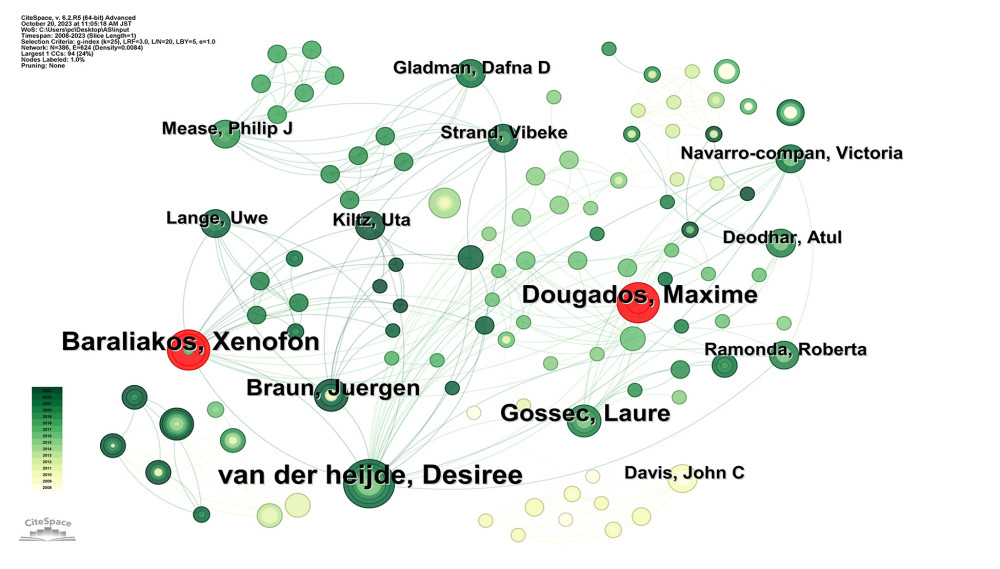 Figure 3. Map of authors related to exercise therapy for back pain in ankylosing spondylitis. CiteSpace 6.2.R5 was created by Dr. Chaomei Chen, Professor of Computer and Information Science at Drexel University in the United States.
Figure 3. Map of authors related to exercise therapy for back pain in ankylosing spondylitis. CiteSpace 6.2.R5 was created by Dr. Chaomei Chen, Professor of Computer and Information Science at Drexel University in the United States. 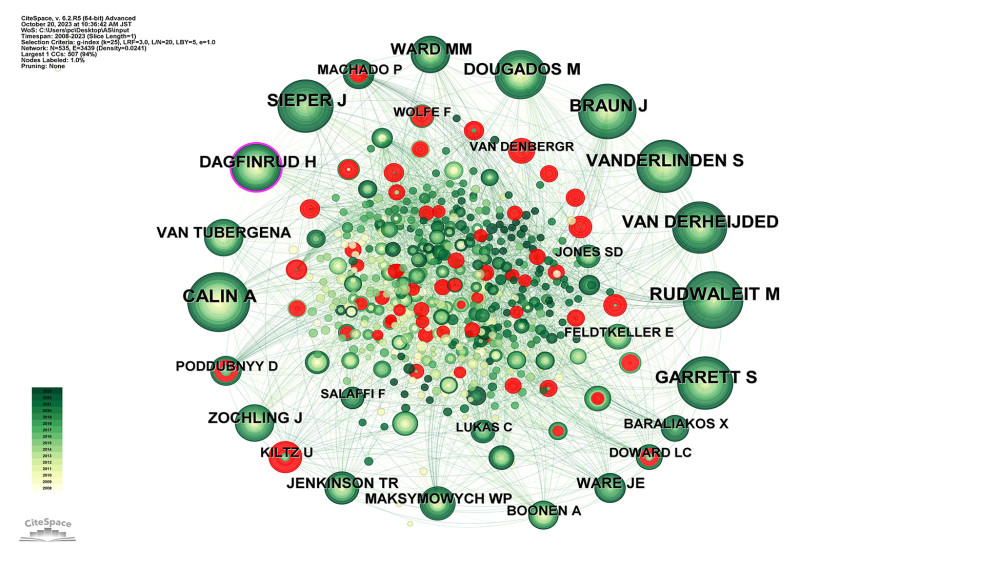 Figure 4. Map of cited authors related to exercise therapy for back pain in ankylosing spondylitis. CiteSpace 6.2.R5 was created by Dr. Chaomei Chen, Professor of Computer and Information Science at Drexel University in the United States.
Figure 4. Map of cited authors related to exercise therapy for back pain in ankylosing spondylitis. CiteSpace 6.2.R5 was created by Dr. Chaomei Chen, Professor of Computer and Information Science at Drexel University in the United States. 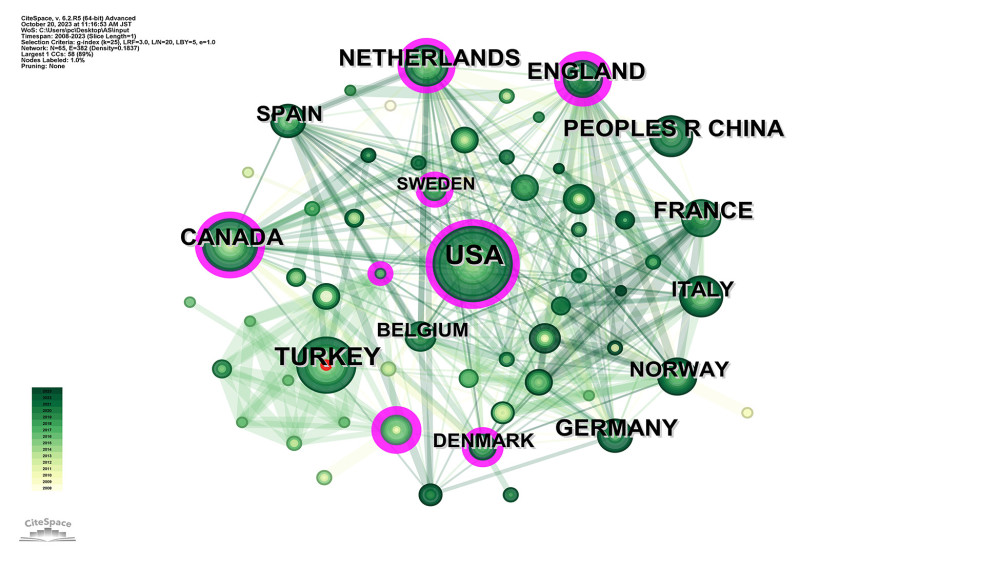 Figure 5. Map of countries related to exercise therapy for back pain in ankylosing spondylitis. CiteSpace 6.2.R5 was created by Dr. Chaomei Chen, Professor of Computer and Information Science at Drexel University in the United States.
Figure 5. Map of countries related to exercise therapy for back pain in ankylosing spondylitis. CiteSpace 6.2.R5 was created by Dr. Chaomei Chen, Professor of Computer and Information Science at Drexel University in the United States. 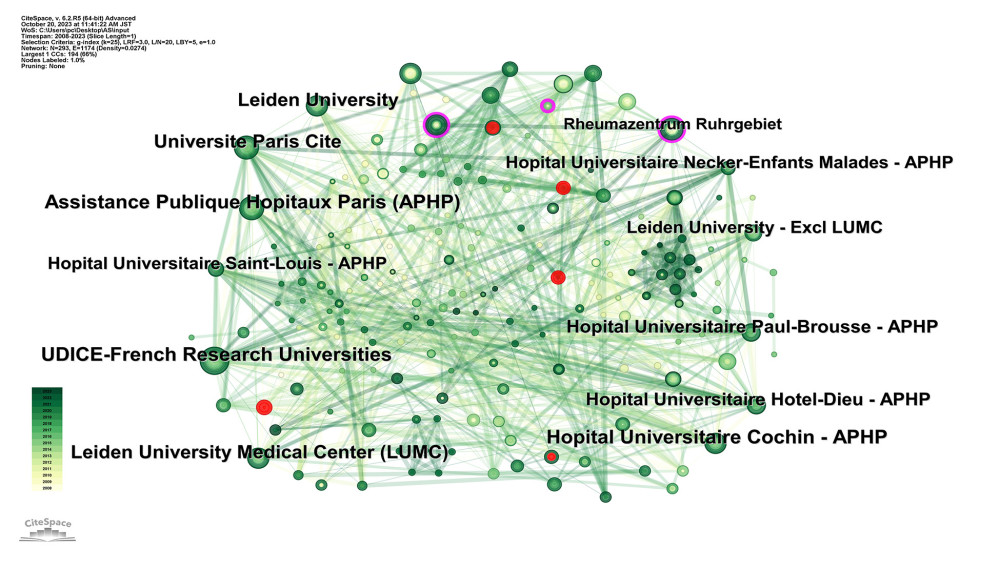 Figure 6. Map of institutions related to exercise therapy for back pain in ankylosing spondylitis. CiteSpace 6.2.R5 was created by Dr. Chaomei Chen, Professor of Computer and Information Science at Drexel University in the United States.
Figure 6. Map of institutions related to exercise therapy for back pain in ankylosing spondylitis. CiteSpace 6.2.R5 was created by Dr. Chaomei Chen, Professor of Computer and Information Science at Drexel University in the United States. 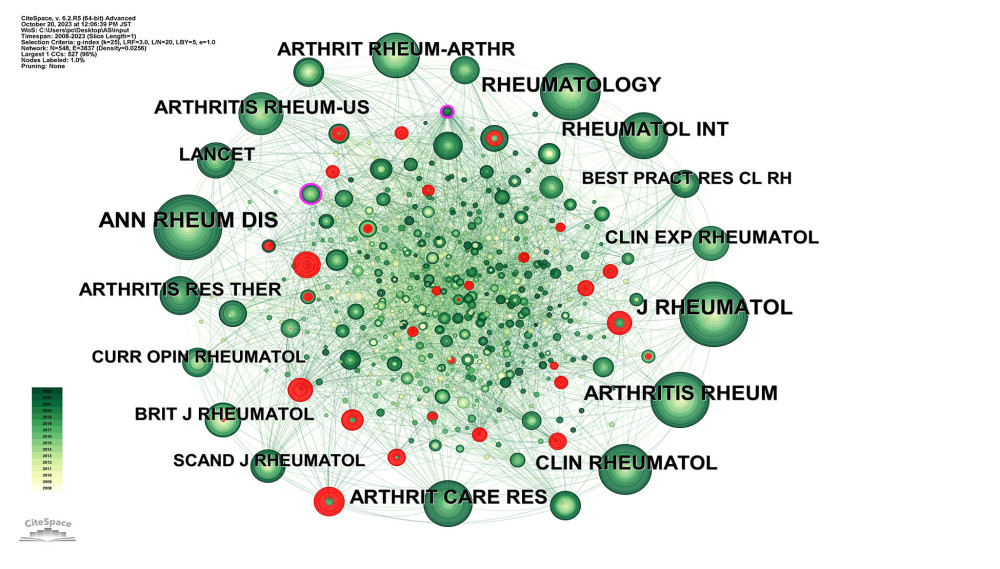 Figure 7. Map of cited journals related to exercise therapy for back pain in ankylosing spondylitis. CiteSpace 6.2.R5 was created by Dr. Chaomei Chen, Professor of Computer and Information Science at Drexel University in the United States.
Figure 7. Map of cited journals related to exercise therapy for back pain in ankylosing spondylitis. CiteSpace 6.2.R5 was created by Dr. Chaomei Chen, Professor of Computer and Information Science at Drexel University in the United States. 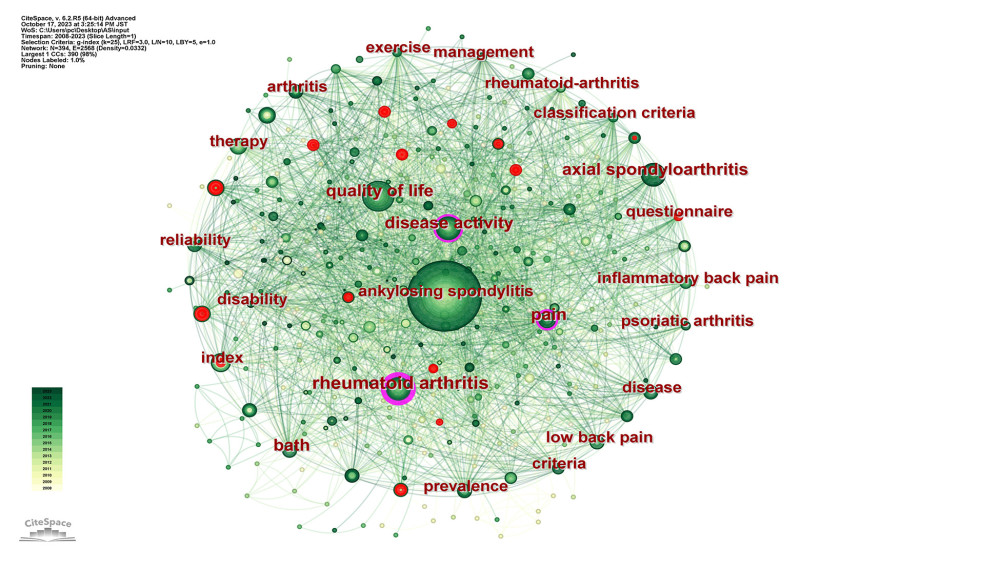 Figure 8. Map of keywords related to exercise therapy for back pain in ankylosing spondylitis. CiteSpace 6.2.R5 was created by Dr. Chaomei Chen, Professor of Computer and Information Science at Drexel University in the United States.
Figure 8. Map of keywords related to exercise therapy for back pain in ankylosing spondylitis. CiteSpace 6.2.R5 was created by Dr. Chaomei Chen, Professor of Computer and Information Science at Drexel University in the United States. 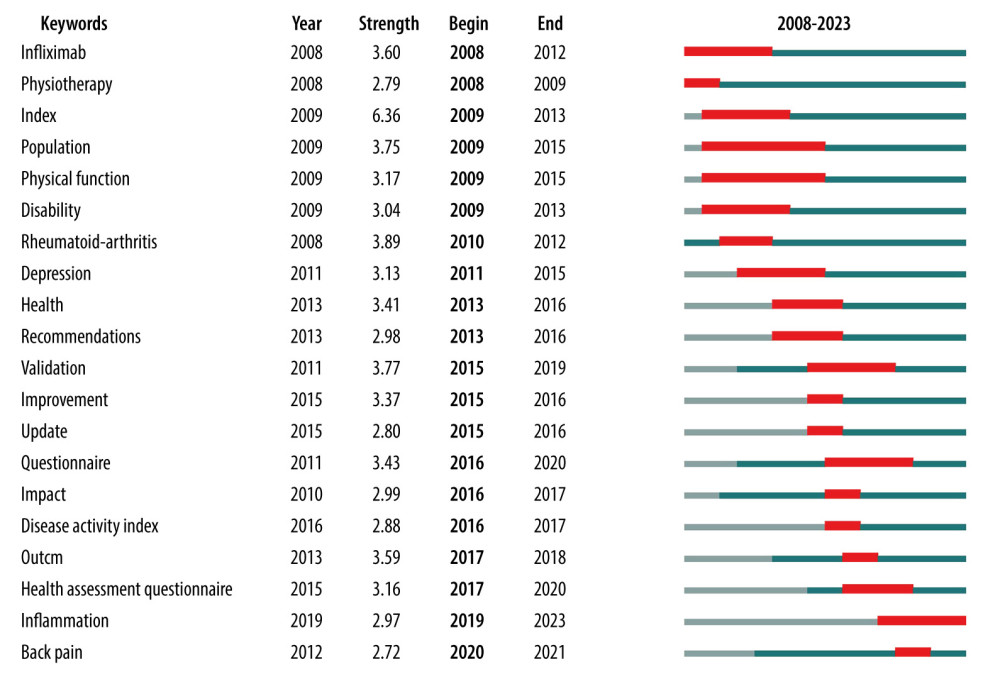 Figure 9. Top 20 keywords with the strongest citation bursts. CiteSpace 6.2.R5 was created by Dr. Chaomei Chen, Professor of Computer and Information Science at Drexel University in the United States.
Figure 9. Top 20 keywords with the strongest citation bursts. CiteSpace 6.2.R5 was created by Dr. Chaomei Chen, Professor of Computer and Information Science at Drexel University in the United States. 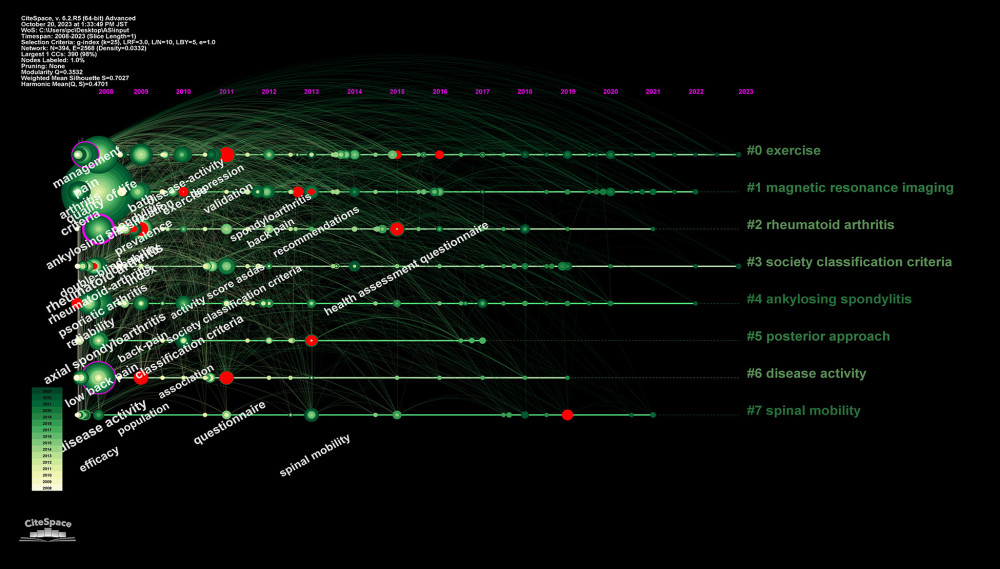 Figure 10. Map of keywords timeline related to exercise therapy for back pain in ankylosing spondylitis. CiteSpace 6.2.R5 was created by Dr. Chaomei Chen, Professor of Computer and Information Science at Drexel University in the United States.
Figure 10. Map of keywords timeline related to exercise therapy for back pain in ankylosing spondylitis. CiteSpace 6.2.R5 was created by Dr. Chaomei Chen, Professor of Computer and Information Science at Drexel University in the United States. 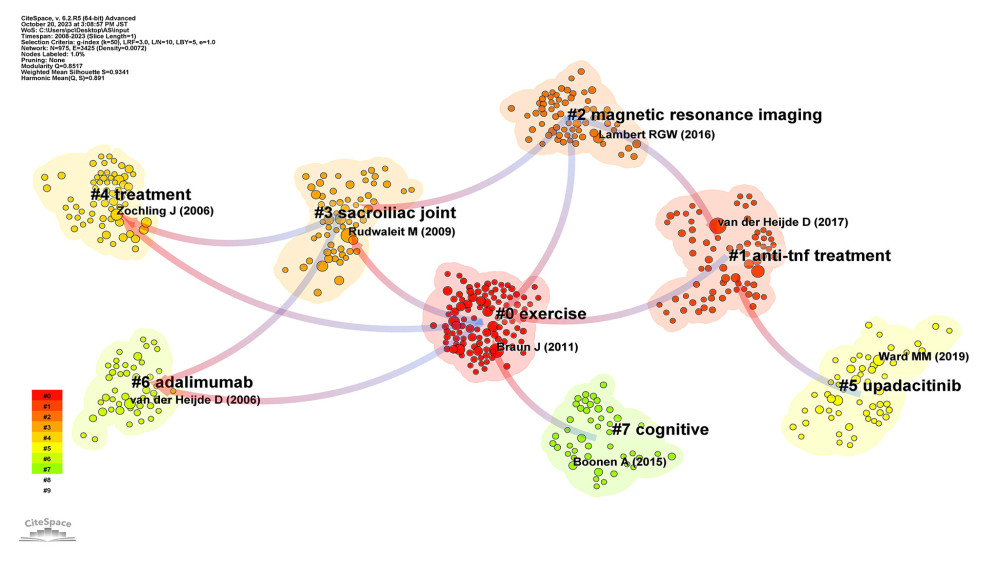 Figure 11. Map of reference of cluster dependencies related to exercise therapy for back pain in ankylosing spondylitis. CiteSpace 6.2.R5 was created by Dr. Chaomei Chen, Professor of Computer and Information Science at Drexel University in the United States.
Figure 11. Map of reference of cluster dependencies related to exercise therapy for back pain in ankylosing spondylitis. CiteSpace 6.2.R5 was created by Dr. Chaomei Chen, Professor of Computer and Information Science at Drexel University in the United States. Tables
Table 1. The topic search query (Web of Science Core Collection <October 16, 2004 to October 15, 2023>).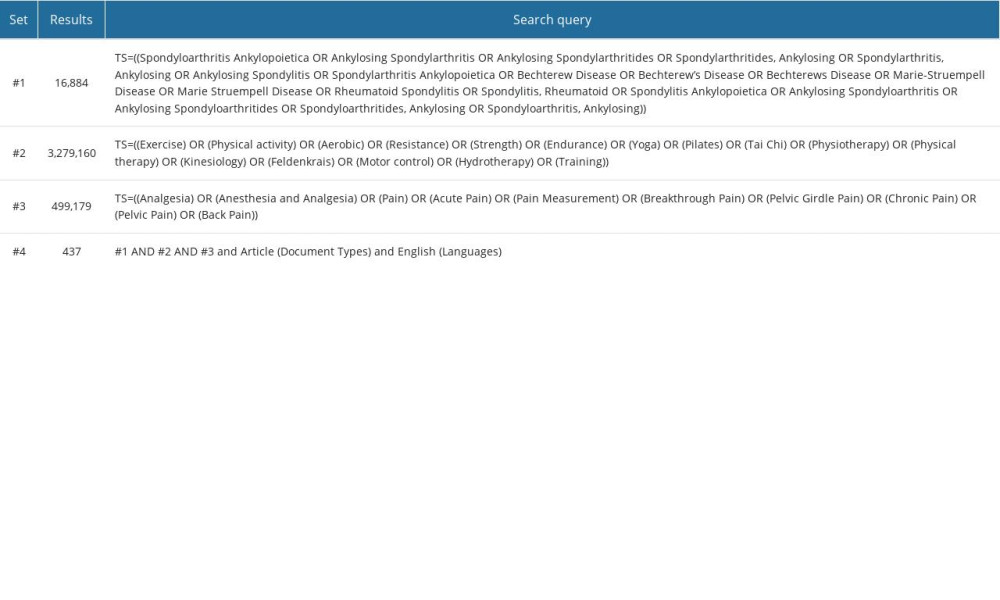 Table 2. Top 10 authors related to exercise therapy for back pain in ankylosing spondylitis.
Table 2. Top 10 authors related to exercise therapy for back pain in ankylosing spondylitis.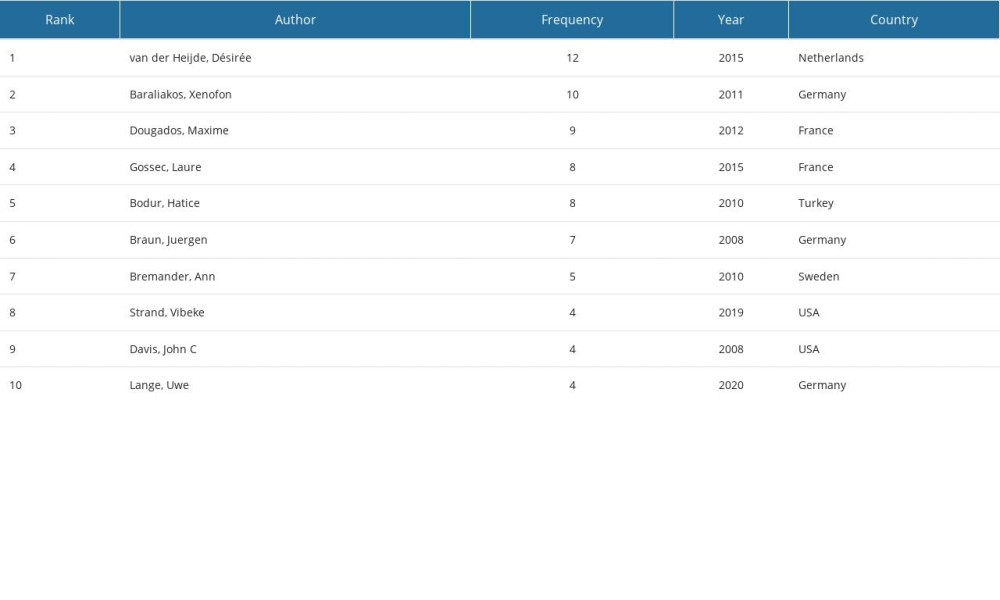 Table 3. Top 10 frequency and centrality of cited authors related to exercise therapy for back pain in ankylosing spondylitis.
Table 3. Top 10 frequency and centrality of cited authors related to exercise therapy for back pain in ankylosing spondylitis.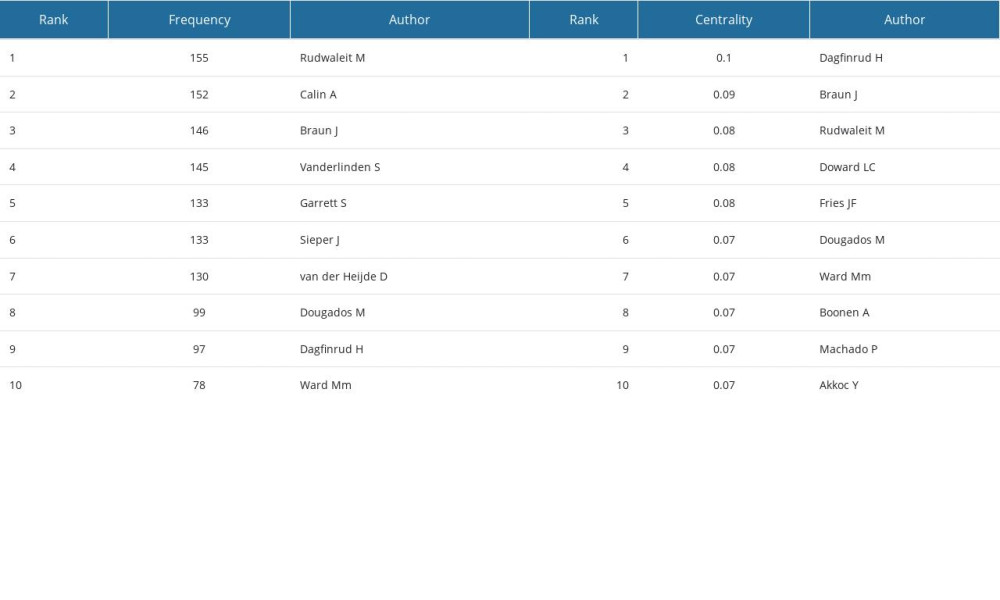 Table 4. Top 10 frequency and centrality of countries related to exercise therapy for back pain in ankylosing spondylitis.
Table 4. Top 10 frequency and centrality of countries related to exercise therapy for back pain in ankylosing spondylitis.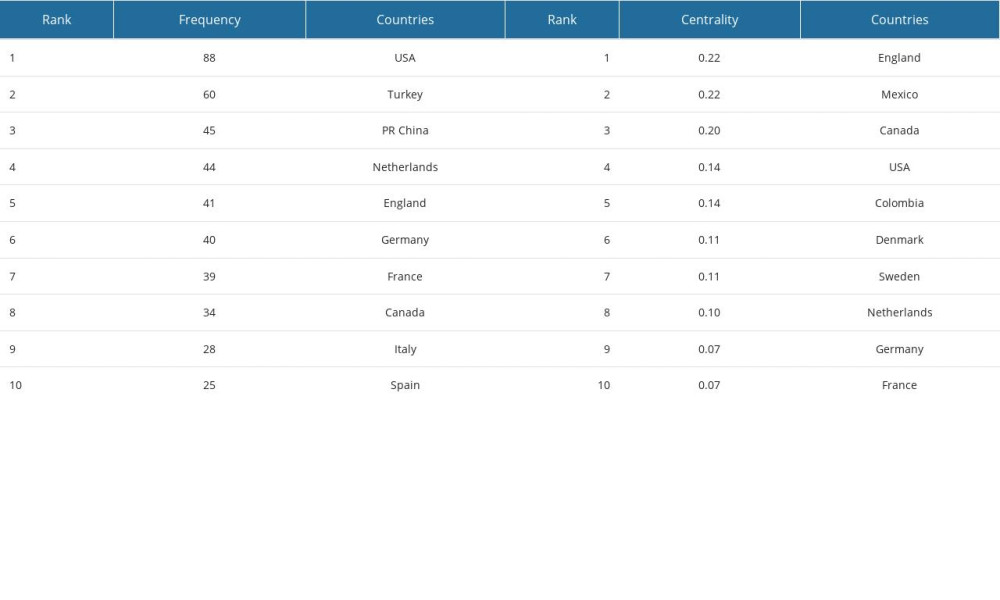 Table 5. Top 10 publications of institutions related to exercise therapy for back pain in ankylosing spondylitis.
Table 5. Top 10 publications of institutions related to exercise therapy for back pain in ankylosing spondylitis.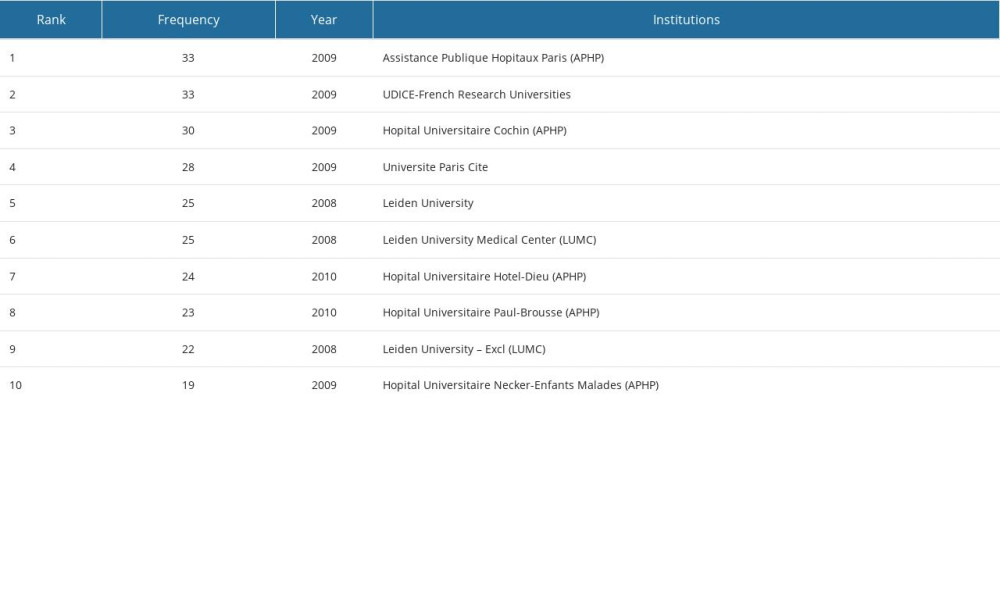 Table 6. Top 10 frequency and centrality of cited journals related to exercise therapy for back pain in ankylosing spondylitis.
Table 6. Top 10 frequency and centrality of cited journals related to exercise therapy for back pain in ankylosing spondylitis.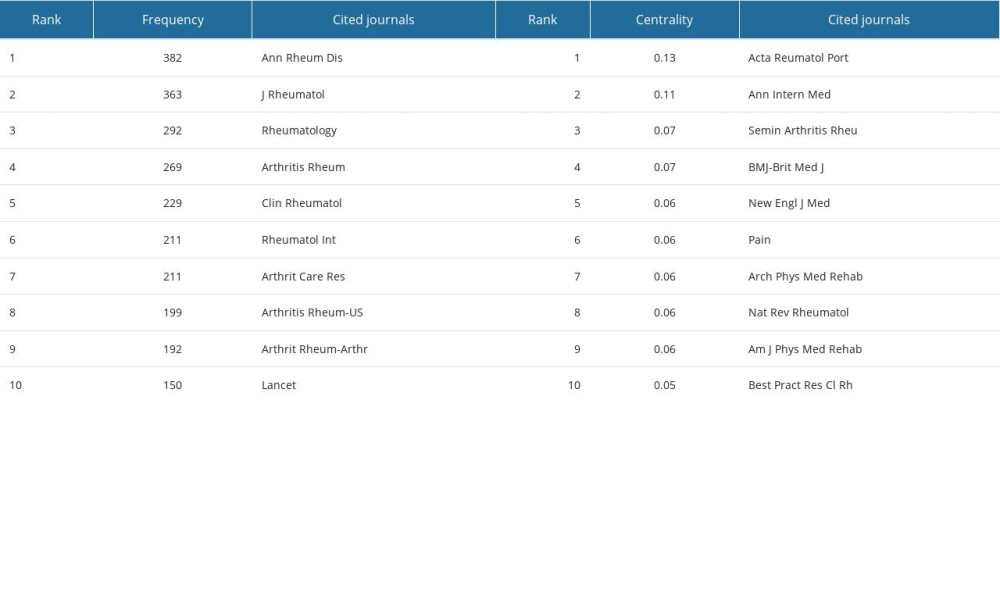 Table 7. Top 10 frequency and centrality of keywords related to exercise therapy for back pain in ankylosing spondylitis.
Table 7. Top 10 frequency and centrality of keywords related to exercise therapy for back pain in ankylosing spondylitis.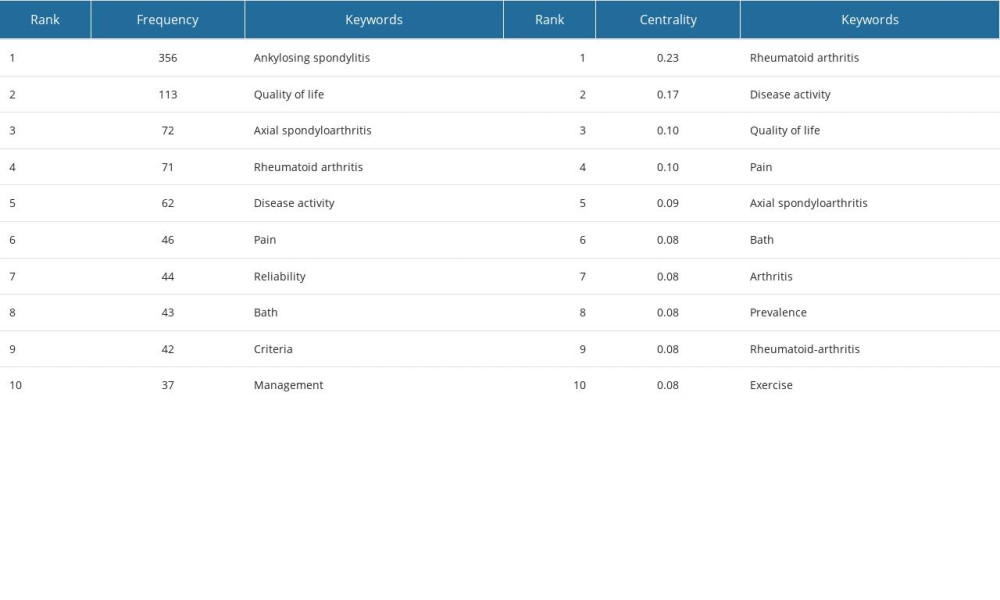
References
1. Taurog JD, Chhabra A, Colbert RA, Ankylosing spondylitis and axial spondyloarthritis: N Engl J Med, 2016; 374(26); 2563-74
2. Garcia-Montoya L, Gul H, Emery P, Recent advances in ankylosing spondylitis: Understanding the disease and management: F1000Res, 2018; 7 F1000 Faculty Rev-1512
3. Mauro D, Thomas R, Guggino G, Ankylosing spondylitis: An autoimmune or autoinflammatory disease?: Nat Rev Rheumatol, 2021; 17(7); 387-404
4. Golder V, Schachna L, Ankylosing spondylitis: An update: Aust Fam Physician, 2013; 42(11); 780-84
5. Xie D, Huang L, Zhao G, Dissecting the underlying pharmaceutical mechanism of Chinese traditional medicine Yun-Pi-Yi-Shen-Tong-Du-Tang acting on ankylosing spondylitis through systems biology approaches: Sci Rep, 2017; 7(1); 13436
6. Haroon NN, Paterson JM, Li P, Increasing proportion of female patients with ankylosing spondylitis: A population-based study of trends in the incidence and prevalence of AS: BMJ Open, 2014; 4(12); e006634
7. Davies H, Brophy S, Dennis M, Patient perspectives of managing fatigue in ankylosing spondylitis, and views on potential interventions: A qualitative study: BMC Musculoskelet Disord, 2013; 14; 163
8. Park JY, Howren AM, Zusman EZ, The incidence of depression and anxiety in patients with ankylosing spondylitis: A systematic review and meta-analysis: BMC Rheumatol, 2020; 4; 12
9. Qian H, Wang X, Wang P, Changes in anxiety and depression after THA in patients with ankylosing spondylitis and the affecting factors: Ther Clin Risk Manag, 2023; 19; 675-84
10. Karatekin BD, Icagasioglu A, Oguz FM, Trajectory of anxiety, depression and quality of life in ankylosing spondylitis: A descriptive study: J Coll Physicians Surg Pak, 2023; 33(3); 314-18
11. Ramiro S, Nikiphorou E, Sepriano A, ASAS-EULAR recommendations for the management of axial spondyloarthritis: 2022 update: Ann Rheum Dis, 2023; 82(1); 19-34
12. Atzeni F, Nucera V, Galloway J, Cardiovascular risk in ankylosing spondylitis and the effect of anti-TNF drugs: A narrative review: Expert Opin Biol Ther, 2020; 20(5); 517-24
13. Yeh BY, Liu GH, Lee TY, Efficacy of Electronic Acupuncture Shoes for Chronic Low Back Pain: Double-Blinded Randomized Controlled Trial: J Med Internet Res Oct 26, 2020; 22(10); e22324
14. Hou YY, Cai YQ, Pan ZZ, GluA1 in central amygdala promotes opioid use and reverses inhibitory effect of pain: Neuroscience, 2020; 426; 141-53
15. Chen XK, Yi ZN, Wong GT, Is exercise a senolytic medicine? A systematic review: Aging Cell, 2021; 20(1); e13294
16. Gur Kabul E, Basakci Calik B, Oztop M, The efficacy of manual soft-tissue mobilization in ankylosing spondylitis: A randomized controlled study: Int J Rheum Dis, 2021; 24(3); 445-55
17. Basakci Calik B, Pekesen Kurtca M, Gur Kabul E, Investigation of the effectiveness of aerobic exercise training in individuals with ankylosing spondylitis: Randomized controlled study: Mod Rheumatol, 2021; 31(2); 442-50
18. Wang Y, Liu X, Wang W, Adherence, efficacy, and safety of wearable technology-assisted combined home-based exercise in Chinese patients with ankylosing spondylitis: Randomized pilot controlled clinical trial: J Med Internet Res, 2022; 24(1); e29703
19. Ali Ismail AM, Abd El-Azeim AS, El-Sayed Felaya EE, Integrated neuromuscular inhibition technique versus spray and stretch technique in neck pain patients with upper trapezius trigger points: A randomized clinical trial: J Man Manip Ther, 2023 [Online ahead of print]
20. Hu X, Chen J, Tang W, Effects of exercise programmes on pain, disease activity and function in ankylosing spondylitis: A meta-analysis of randomized controlled trials: Eur J Clin Invest, 2020; 50(12); e13352
21. Pécourneau V, Degboé Y, Barnetche T, Effectiveness of exercise programs in ankylosing spondylitis: A meta-analysis of randomized controlled trials: Arch Phys Med Rehabil, 2018; 99(2); 383-89e1
22. Kan SL, Chen LX, Yuan ZF, Exercise interventions for ankylosing spondylitis: A protocol for a Bayesian network meta-analysis: BMJ Open, 2019; 9(6); e029991
23. Zhou XC, Huang YB, Liu Z, Bibliometric analysis of functional magnetic resonance imaging studies on manual therapy analgesia from 2002–2022: J Pain Res, 2023; 16; 2115-29
24. Zhang XL, Zheng Y, Xia ML, Knowledge domain and emerging trends in vinegar research: A bibliometric review of the literature from WoSCC: Foods, 2020; 9(2); 166
25. Li X, Wei W, Wang Y, Global trend in the research and development of acupuncture treatment on Parkinson’s disease from 2000 to 2021: A bibliometric analysis: Front Neurol, 2022; 13; 906317
26. Liang YD, Li Y, Zhao J, Study of acupuncture for low back pain in recent 20 years: A bibliometric analysis via CiteSpace: J Pain Res, 2017; 10; 951-64
27. Chen YM, Wang XQ, Bibliometric analysis of exercise and neuropathic pain research: J Pain Res, 2020; 13; 1533-45
28. Xi M, Gao X, Bibliometric analysis of research relating to IgA nephropathy from 2010 to 2021: Med Sci Monit, 2022; 28; e937976
29. He Z, Dai L, Zuo Y, Hotspots and frontiers in pulmonary arterial hypertension research: A bibliometric and visualization analysis from 2011 to 2020: Bioengineered, 2022; 13(6); 14667-80
30. Wu F, Gao J, Kang J, Knowledge mapping of exosomes in autoimmune diseases: A bibliometric analysis (2002–2021): Front Immunol, 2022; 13; 939433
31. Chen C, Hu Z, Liu S, Emerging trends in regenerative medicine: A scientometric analysis in CiteSpace: Expert Opin Biol Ther, 2012; 12(5); 593-608
32. Chen C, Dubin R, Kim MC, Emerging trends and new developments in regenerative medicine: A scientometric update (2000–2014): Expert Opin Biol Ther, 2014; 14(9); 1295-317
33. Cruz-Jentoft AJ, Bahat G, Bauer J, Sarcopenia: Revised European consensus on definition and diagnosis: Age Ageing, 2019; 48(4); 601
34. Danve A, Deodhar A, Treatment of axial spondyloarthritis: An update: Nat Rev Rheumatol, 2022; 18(4); 205-16
35. Mandl P, Navarro-Compán V, EULAR recommendations for the use of imaging in the diagnosis and management of spondyloarthritis in clinical practice: Ann Rheum Dis, 2015; 74(7); 1327-39
36. Lambert RG, Bakker PA, van der Heijde D, Defining active sacroiliitis on MRI for classification of axial spondyloarthritis: Update by the ASAS MRI working group: Ann Rheum Dis, 2016; 75(11); 1958-63
37. Yoo DH, Racewicz A, Brzezicki J, A phase III randomized study to evaluate the efficacy and safety of CT-P13 compared with reference infliximab in patients with active rheumatoid arthritis: 54-week results from the PLANETRA study: Arthritis Res Ther, 2016; 18; 82
38. Gwinnutt JM, Wieczorek M, Balanescu A, 2021 EULAR recommendations regarding lifestyle behaviours and work participation to prevent progression of rheumatic and musculoskeletal diseases: Ann Rheum Dis, 2023; 82(1); 48-56
39. Zhang L, Yuan TF, Exercise and substance abuse: Int Rev Neurobiol, 2019; 147; 269-80
40. McInnis LA, Morehead A, Exercise as a therapeutic intervention: Nurs Clin North Am, 2020; 55(4); 543-56
41. Hidalgo JL, Sotos JRDEP-EXERCISE Group, Effectiveness of physical exercise in older adults with mild to moderate depression: Ann Fam Med, 2021; 19(4); 302-9
42. He YH, Comment on: Traditional Chinese eight brocade exercise prescription for ankylosing spondylitis: A quantitative synthesis: Complement Med Res, 2021; 28(2); 177-78
43. Xie Y, Guo F, Lu Y, A 12-week Baduanjin Qigong exercise improves symptoms of ankylosing spondylitis: A randomized controlled trial: Complement Ther Clin Pract, 2019; 36; 113-19
44. Liu W, Fan Y, Wan R, Effects of traditional qigong exercise on ankylosing spondylitis: A protocol for systematic reviews and meta-analysis: BMJ Open, 2021; 11(4); e046188
45. Medrado LN, Mendonça MLM, Budib MB, Effectiveness of aquatic exercise in the treatment of inflammatory arthritis: Systematic review: Rheumatol Int, 2022; 42(10); 1681-91
46. Liang Z, Fu C, Zhang Q, Effects of water therapy on disease activity, functional capacity, spinal mobility and severity of pain in patients with ankylosing spondylitis: A systematic review and meta-analysis: Disabil Rehabil, 2021; 43(7); 895-902
47. Zão A, Cantista P, The role of land and aquatic exercise in ankylosing spondylitis: A systematic review: Rheumatol Int, 2017; 37(12); 1979-90
48. Souza MC, Jennings F, Morimoto H, Swiss ball exercises improve muscle strength and walking performance in ankylosing spondylitis: A randomized controlled trial: Rev Bras Reumatol Engl Ed, 2017; 57(1); 45-55
49. Byrnes K, Wu PJ, Whillier S, Is pilates an effective rehabilitation tool? A systematic review: J Bodyw Mov Ther, 2018; 22(1); 192-202
50. Boudjani R, Challal S, Semerano L, Impact of different types of exercise programs on ankylosing spondylitis: A systematic review and meta-analysis: Disabil Rehabil, 2023; 45(24); 3989-4000
51. Hosseini M, Rahimibarghani S, Ghorbanpour S, The effects of supervision on the outcomes of exercise training in patients with ankylosing spondylitis: A single-blind randomized controlled trial: Int J Rheum Dis, 2023; 26(6); 1120-28
52. Liang H, Xu L, Tian X, The comparative efficacy of supervised- versus home-based exercise programs in patients with ankylosing spondylitis: A meta-analysis: Medicine (Baltimore), 2020; 99(8); e19229
53. Harpham C, Harpham QK, Barker AR, The effect of exercise training programs with aerobic components on C-reactive protein, erythrocyte sedimentation rate and self-assessed disease activity in people with ankylosing spondylitis: A systematic review and meta-analysis: Int J Rheum Dis, 2022; 25(6); 635-49
54. Líška D, Exercise in the treatment of ankylosing spondylitis: Vnitr Lek, 2022; 68(E-1); 16-21
55. Nolte K, van Rensburg DCJ, Fletcher L, Effects of a 6-month exercise programme on disease activity, physical and functional parameters in patients with ankylosing spondylitis: Randomised controlled trial: S Afr J Physiother, 2021; 77(1); 1546
56. Sveaas SH, Bilberg A, Berg IJ, High intensity exercise for 3 months reduces disease activity in axial spondyloarthritis (axSpA): A multicentre randomised trial of 100 patients: Br J Sports Med, 2020; 54(5); 292-97
57. Thudium CS, Nielsen SH, Sardar S, Bone phenotypes in rheumatology – there is more to bone than just bone: BMC Musculoskelet Disord, 2020; 21(1); 789
Figures
 Figure 1. Map of literature screening process related to exercise therapy for back pain in ankylosing spondylitis. CiteSpace 6.2.R5 was created by Dr. Chaomei Chen, Professor of Computer and Information Science at Drexel University in the United States.
Figure 1. Map of literature screening process related to exercise therapy for back pain in ankylosing spondylitis. CiteSpace 6.2.R5 was created by Dr. Chaomei Chen, Professor of Computer and Information Science at Drexel University in the United States. Figure 2. Map of annual publications related to exercise therapy for back pain in ankylosing spondylitis. CiteSpace 6.2.R5 was created by Dr. Chaomei Chen, Professor of Computer and Information Science at Drexel University in the United States.
Figure 2. Map of annual publications related to exercise therapy for back pain in ankylosing spondylitis. CiteSpace 6.2.R5 was created by Dr. Chaomei Chen, Professor of Computer and Information Science at Drexel University in the United States. Figure 3. Map of authors related to exercise therapy for back pain in ankylosing spondylitis. CiteSpace 6.2.R5 was created by Dr. Chaomei Chen, Professor of Computer and Information Science at Drexel University in the United States.
Figure 3. Map of authors related to exercise therapy for back pain in ankylosing spondylitis. CiteSpace 6.2.R5 was created by Dr. Chaomei Chen, Professor of Computer and Information Science at Drexel University in the United States. Figure 4. Map of cited authors related to exercise therapy for back pain in ankylosing spondylitis. CiteSpace 6.2.R5 was created by Dr. Chaomei Chen, Professor of Computer and Information Science at Drexel University in the United States.
Figure 4. Map of cited authors related to exercise therapy for back pain in ankylosing spondylitis. CiteSpace 6.2.R5 was created by Dr. Chaomei Chen, Professor of Computer and Information Science at Drexel University in the United States. Figure 5. Map of countries related to exercise therapy for back pain in ankylosing spondylitis. CiteSpace 6.2.R5 was created by Dr. Chaomei Chen, Professor of Computer and Information Science at Drexel University in the United States.
Figure 5. Map of countries related to exercise therapy for back pain in ankylosing spondylitis. CiteSpace 6.2.R5 was created by Dr. Chaomei Chen, Professor of Computer and Information Science at Drexel University in the United States. Figure 6. Map of institutions related to exercise therapy for back pain in ankylosing spondylitis. CiteSpace 6.2.R5 was created by Dr. Chaomei Chen, Professor of Computer and Information Science at Drexel University in the United States.
Figure 6. Map of institutions related to exercise therapy for back pain in ankylosing spondylitis. CiteSpace 6.2.R5 was created by Dr. Chaomei Chen, Professor of Computer and Information Science at Drexel University in the United States. Figure 7. Map of cited journals related to exercise therapy for back pain in ankylosing spondylitis. CiteSpace 6.2.R5 was created by Dr. Chaomei Chen, Professor of Computer and Information Science at Drexel University in the United States.
Figure 7. Map of cited journals related to exercise therapy for back pain in ankylosing spondylitis. CiteSpace 6.2.R5 was created by Dr. Chaomei Chen, Professor of Computer and Information Science at Drexel University in the United States. Figure 8. Map of keywords related to exercise therapy for back pain in ankylosing spondylitis. CiteSpace 6.2.R5 was created by Dr. Chaomei Chen, Professor of Computer and Information Science at Drexel University in the United States.
Figure 8. Map of keywords related to exercise therapy for back pain in ankylosing spondylitis. CiteSpace 6.2.R5 was created by Dr. Chaomei Chen, Professor of Computer and Information Science at Drexel University in the United States. Figure 9. Top 20 keywords with the strongest citation bursts. CiteSpace 6.2.R5 was created by Dr. Chaomei Chen, Professor of Computer and Information Science at Drexel University in the United States.
Figure 9. Top 20 keywords with the strongest citation bursts. CiteSpace 6.2.R5 was created by Dr. Chaomei Chen, Professor of Computer and Information Science at Drexel University in the United States. Figure 10. Map of keywords timeline related to exercise therapy for back pain in ankylosing spondylitis. CiteSpace 6.2.R5 was created by Dr. Chaomei Chen, Professor of Computer and Information Science at Drexel University in the United States.
Figure 10. Map of keywords timeline related to exercise therapy for back pain in ankylosing spondylitis. CiteSpace 6.2.R5 was created by Dr. Chaomei Chen, Professor of Computer and Information Science at Drexel University in the United States. Figure 11. Map of reference of cluster dependencies related to exercise therapy for back pain in ankylosing spondylitis. CiteSpace 6.2.R5 was created by Dr. Chaomei Chen, Professor of Computer and Information Science at Drexel University in the United States.
Figure 11. Map of reference of cluster dependencies related to exercise therapy for back pain in ankylosing spondylitis. CiteSpace 6.2.R5 was created by Dr. Chaomei Chen, Professor of Computer and Information Science at Drexel University in the United States. Tables
 Table 1. The topic search query (Web of Science Core Collection <October 16, 2004 to October 15, 2023>).
Table 1. The topic search query (Web of Science Core Collection <October 16, 2004 to October 15, 2023>). Table 2. Top 10 authors related to exercise therapy for back pain in ankylosing spondylitis.
Table 2. Top 10 authors related to exercise therapy for back pain in ankylosing spondylitis. Table 3. Top 10 frequency and centrality of cited authors related to exercise therapy for back pain in ankylosing spondylitis.
Table 3. Top 10 frequency and centrality of cited authors related to exercise therapy for back pain in ankylosing spondylitis. Table 4. Top 10 frequency and centrality of countries related to exercise therapy for back pain in ankylosing spondylitis.
Table 4. Top 10 frequency and centrality of countries related to exercise therapy for back pain in ankylosing spondylitis. Table 5. Top 10 publications of institutions related to exercise therapy for back pain in ankylosing spondylitis.
Table 5. Top 10 publications of institutions related to exercise therapy for back pain in ankylosing spondylitis. Table 6. Top 10 frequency and centrality of cited journals related to exercise therapy for back pain in ankylosing spondylitis.
Table 6. Top 10 frequency and centrality of cited journals related to exercise therapy for back pain in ankylosing spondylitis. Table 7. Top 10 frequency and centrality of keywords related to exercise therapy for back pain in ankylosing spondylitis.
Table 7. Top 10 frequency and centrality of keywords related to exercise therapy for back pain in ankylosing spondylitis. Table 1. The topic search query (Web of Science Core Collection <October 16, 2004 to October 15, 2023>).
Table 1. The topic search query (Web of Science Core Collection <October 16, 2004 to October 15, 2023>). Table 2. Top 10 authors related to exercise therapy for back pain in ankylosing spondylitis.
Table 2. Top 10 authors related to exercise therapy for back pain in ankylosing spondylitis. Table 3. Top 10 frequency and centrality of cited authors related to exercise therapy for back pain in ankylosing spondylitis.
Table 3. Top 10 frequency and centrality of cited authors related to exercise therapy for back pain in ankylosing spondylitis. Table 4. Top 10 frequency and centrality of countries related to exercise therapy for back pain in ankylosing spondylitis.
Table 4. Top 10 frequency and centrality of countries related to exercise therapy for back pain in ankylosing spondylitis. Table 5. Top 10 publications of institutions related to exercise therapy for back pain in ankylosing spondylitis.
Table 5. Top 10 publications of institutions related to exercise therapy for back pain in ankylosing spondylitis. Table 6. Top 10 frequency and centrality of cited journals related to exercise therapy for back pain in ankylosing spondylitis.
Table 6. Top 10 frequency and centrality of cited journals related to exercise therapy for back pain in ankylosing spondylitis. Table 7. Top 10 frequency and centrality of keywords related to exercise therapy for back pain in ankylosing spondylitis.
Table 7. Top 10 frequency and centrality of keywords related to exercise therapy for back pain in ankylosing spondylitis. In Press
11 Mar 2024 : Clinical Research
Enhancement of Frozen-Thawed Human Sperm Quality with Zinc as a Cryoprotective AdditiveMed Sci Monit In Press; DOI: 10.12659/MSM.942946
12 Mar 2024 : Database Analysis
Risk Factors of Age-Related Macular Degeneration in a Population-Based Study: Results from SHIP-TREND-1 (St...Med Sci Monit In Press; DOI: 10.12659/MSM.943140
12 Mar 2024 : Clinical Research
Preoperative Blood Transfusion Requirements for Hemorrhoidal Severe Anemia: A Retrospective Study of 128 Pa...Med Sci Monit In Press; DOI: 10.12659/MSM.943126
12 Mar 2024 : Clinical Research
Tissue Inhibitors of Metalloproteinase 1 (TIMP-1) and 3 (TIMP-3) as New Markers of Acute Kidney Injury Afte...Med Sci Monit In Press; DOI: 10.12659/MSM.943500
Most Viewed Current Articles
17 Jan 2024 : Review article
Vaccination Guidelines for Pregnant Women: Addressing COVID-19 and the Omicron VariantDOI :10.12659/MSM.942799
Med Sci Monit 2024; 30:e942799
14 Dec 2022 : Clinical Research
Prevalence and Variability of Allergen-Specific Immunoglobulin E in Patients with Elevated Tryptase LevelsDOI :10.12659/MSM.937990
Med Sci Monit 2022; 28:e937990
16 May 2023 : Clinical Research
Electrophysiological Testing for an Auditory Processing Disorder and Reading Performance in 54 School Stude...DOI :10.12659/MSM.940387
Med Sci Monit 2023; 29:e940387
01 Jan 2022 : Editorial
Editorial: Current Status of Oral Antiviral Drug Treatments for SARS-CoV-2 Infection in Non-Hospitalized Pa...DOI :10.12659/MSM.935952
Med Sci Monit 2022; 28:e935952








